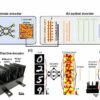Imagine if your dead laptop or phone could charge in a minute or if an electric car could be fully powered in 10 minutes.
While not possible yet, new research by a team of CU Boulder scientists could potentially lead to such advances.
Published today in the Proceedings of the National Academy of Sciences, researchers in Ankur Gupta’s lab discovered how tiny charged particles, called ions, move within a complex network of minuscule pores. The breakthrough could lead to the development of more efficient energy storage devices, such as supercapacitors, said Gupta, an assistant professor of chemical and biological engineering.
“Given the critical role of energy in the future of the planet, I felt inspired to apply my chemical engineering knowledge to advancing energy storage devices,” Gupta said. “It felt like the topic was somewhat underexplored and, as such, the perfect opportunity.”
Gupta explained that several chemical engineering techniques are used to study flow in porous materials such as oil reservoirs and water filtration, but they have not been fully utilized in some energy storage systems.
The discovery is significant not only for storing energy in vehicles and electronic devices but also for power grids, where fluctuating energy demand requires efficient storage to avoid waste during periods of low demand and to ensure rapid supply during high demand.
Supercapacitors, energy storage devices that rely on ion accumulation in their pores, have rapid charging times and longer life spans compared to batteries.
“The primary appeal of supercapacitors lies in their speed,” Gupta said. “So how can we make their charging and release of energy faster? By the more efficient movement of ions.”
Their findings modify Kirchhoff’s law, which has governed current flow in electrical circuits since 1845 and is a staple in high school students’ science classes. Unlike electrons, ions move due to both electric fields and diffusion, and the researchers determined that their movements at pore intersections are different from what was described in Kirchhoff’s law.
Prior to the study, ion movements were only described in the literature in one straight pore. Through this research, ion movement in a complex network of thousands of interconnected pores can be simulated and predicted in a few minutes.
“That’s the leap of the work,” Gupta said. “We found the missing link.”
More information:
Filipe Henrique et al, A network model to predict ionic transport in porous materials, Proceedings of the National Academy of Sciences (2024). DOI: 10.1073/pnas.2401656121
Provided by
University of Colorado at Boulder
Citation:
Charge your laptop in a minute? Supercapacitors can help; new research offers clues (2024, May 25)



